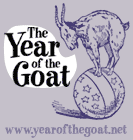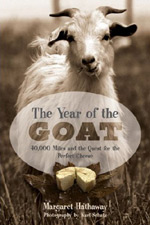 |
| Callene Rapp, senior keeper at the Sedgwick County Zoo in Wichita, Kansas feeds the zoo's Nigerian Dwarf goats | more zoo photos |
We scheduled our visit to the goats of the Sedgwick County Zoo during one of those improbably temperate weeks that sometimes drift across the Plains in midwinter. By the time our appointment arrived, the weather had shifted to cold winter rain. We postponed once, then rescheduled for a day that came with temperatures in the teens, biting winds, and a flat leaden sky that periodically spit on us. Bundled up in the parking lot, we braced ourselves to get out of the car, and went into the zoo fully expecting the animals to be hidden away in their stalls. Amazingly, all of them —even the African and Asian species— were outside.
Callene Rapp, the senior zookeeper who spoke with us in the petting zoo, said that most of the animals have adapted to Kansas weather, and at night, when we would have thought they were tucked warmly in the barns, all of the animals from the petting zoo sleep together in one pasture. It's not quite the lion laying down with the lamb, since these are all domesticated animals and none of them are carnivorous. But the zebus, the pigs, the camels, the yaks and the goats, animals that outside of a zoo setting wouldn't be found in the same hemisphere, huddle together through the night in one pasture.
During the day, the petting zoo is divided into three exhibits: those of Asian livestock, African livestock, and American livestock. For each exhibit, Callene tries to acquire endangered livestock and what we had heard termed "heritage breeds": animals that are less commonly bred today but at one time were inhabitants of the average farm. Her acquisitions include Hereford Pigs, Scottish Highland Cattle, and three varieties of goats: Nigerian Dwarf, San Clemente, and Arapawa Island.
It hadn't occurred to us that with the decline of family farms in America, there would be a loss of habitat for certain livestock, and that these breeds would become endangered. When we think of endangered species, we think of tigers and rhinos, not shaggy haired cows or oversized pigs. Callene explained to us that with commercial farming, animals are bred for short, productive (meaning quick weight gain), and confined lives. Animals that don't fit into that plan are not profitable, and their numbers have gradually dwindled. Though there are some farmers who've taken an interest in the heritage breeds, their numbers, and their farms' profits, are not large enough to successfully combat the problem; of some breeds, there are fewer than one hundred animals left. While some of these animals' numbers have declined due to aggressive action, the populations of most endangered livestock breeds have dwindled in a passive way. When their product —generally meat— fails to turn a profit, they are phased out of their farmer's breeding program.
In 1977, when the plight of the heritage breeds first became apparent, a group of ecologically minded farmers, zoo keepers and scientist formed the American Livestock Breeds Conservancy (ALBC), of which Callene is now a board member. The group, which has steadily grown since its inception, tracks population size and genetic health of endangered breeds, sponsors research on measures that could combat their endangerment, maintains a genetic bank of rare livestock, rescues and finds new homes for animals facing extinction (such as the San Clemente goat, of which there are now several in the Sedgwick County Zoo), and gives a variety of educational programs about both individual breeds and sustainable agriculture. Through the dedication of its members, the ALBC's efforts are meeting with real success, and as we wandered around the farm, Callene showed us which breeds had been gaining in numbers.
One of our most beloved animals at the zoo —not, alas, a goat— is among the breeds that are showing improvement. Lucille, a red Hereford Pig who stands nearly five feet tall and has pointy, erect ears, had long been on our list of personal favorites. Even when she's just rooting around in her stall, she gives off, like a goat, an air of intelligence. As it turns out, she's also an artist. Before we left, Callene gave us one of Lucille's works, a painting on canvas in reds and purples and a little corn, that she made with her snout. It's now proudly displayed in the dining room. If for no other reason than Lucille's artistic career, the ALBC and the livestock program at the Sedgwick County Zoo seem to us endeavors that deserve support. —MMH




